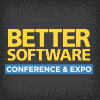Better Software Conference & EXPO 2008

PRESENTATIONS
|
A Kanban System for Software Engineering
Ideas from Lean Thinking have been growing in popularity with the Agile software development community. Over the past year, the use of kanban (literally signal cards) popular in manufacturing has been seen as the significant innovation in managing agile work and is growing in adoption at firms such as Yahoo! David Anderson introduced the first electronic kanban system at Microsoft in 2004 and has since extended the technique through his work at Corbis. |
|
|
A Toolkit for Assessing SOA Readiness
Before charging "full speed ahead" into the land of service-oriented architecture (SOA), you need help to ensure success and mitigate the risks inherent in such major systems changes. Jerry Smith provides proven tools for assessing SOA readiness and outlines the essential steps to implementing SOA. Jerry presents reference SOA architectures that demonstrate solid standards and specifications to compare with your implementation plans. |
|
|
Agile and the Seven Deadly Sins of Project Management
Agile approaches to software development promise many advantages: shorter schedules, more productive teams, products that better meet customer expectations, higher quality, and more. In this talk, Mike will explain how agile teams achieve these goals by avoiding the seven deadly sins of project management. Covered will be sins such as gluttony, sloth, lust, opaqueness, and more. Giving in to one of these temptations can result in a failed or cancelled project. |
|
|
Agile in the Non-Agile Enterprise: Hurdling Obstacles
Agile is entering the mainstream as a software development practice and leading wider organizational change in many companies. However, in large organizations, it's not practical just to "flip a switch" and have your entire software department "go agile" all at once. In that situation, agile and non-agile teams must work together during the transition. Agile teams must continue to interface with their company's business processes, while management must streamline traditional processes and activities. |
|
|
Agile Leadership: Coaching Great Teams
When adopting agile methods, many project managers find it difficult to move from a traditional, control-based model to a servant-leader based model. This paradigm challenges managers to their core because agility demands a coaching-driven mindset rather than the classic "I'm-in-charge" view. Explore the core aspects of agile leadership and team coaching with Bob Galen as you look at leadership from an agile perspective. |
|
|
An Alternative to Consensus: Accelerating Effective Decisions
Software development teams don't always need, want, or have time to make decisions via group consensus. And project leaders often already feel over-burdened with the multiple decisions they have to make on their own. But there is a middle path-an alternative to consensus-in which shared responsibility for decision-making provides for input from many and one voice to represent the team and make the final choice. |
|
|
Answer the Call: Help Product Owners Define and Prioritze Requirements
Numerous software development methodologies are available to provide project teams excellent guidance on how to build systems right. But how do we know that we are building the right systems? We often ask product owners to define and prioritize their requirements-without offering them a great deal of guidance on how to do so. Understanding what the software needs to do and the value that it will add to the organization will help them decide the importance of each requirement. |
|
|
Attacking Waste in Software: Three Practices We Must Embrace Now
One of the seven principles of Lean Thinking is "eliminate waste." Eliminating waste means minimizing the cost of the resources we use to deliver software to our stakeholders. Jean Tabaka proposes three pivotal practices that we must embrace to aggressively attack waste in software delivery—Software as a Service (SaaS), Community, and Fast Feature Throughput. SaaS eliminates waste by deploying software-based services without the cost inherent in traditional software delivery—materials, shipping, time delay, and more. |
|
|
Bandages or Tombstones? Distinguishing Between Minor Setbacks and Impending Doom
Are the challenges confronting your project normal and treatable setbacks or signs of something more serious? Can we treat them with a Band-Aid® and a kiss? Should we call the ambulance? The undertaker? Payson Hall shares patterns he’s observed while consulting on dozens of large software development and systems integration projects-executive sponsors distancing themselves from your project, ebbing morale, aggressive schedules, and more. |

Payson Hall, Catalysis Group Inc |
|
Better Software Conference & EXPO 2008: Automating Security Testing with cUrl and Perl
Although all teams want to test their applications for security, our plates are already full with functional tests. What if we could automate those security tests? Fortunately, most Web-based and desktop applications submit readily to automated testing. Paco Hope explores two flexible, powerful, and totally free tools that can help to automate security tests. cUrl is a free program that issues automatic basic Web requests; Perl is a well-known programming language ideally suited for writing test scripts. |

Paco Hope, Cigital |


